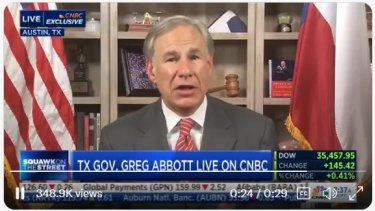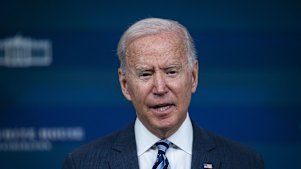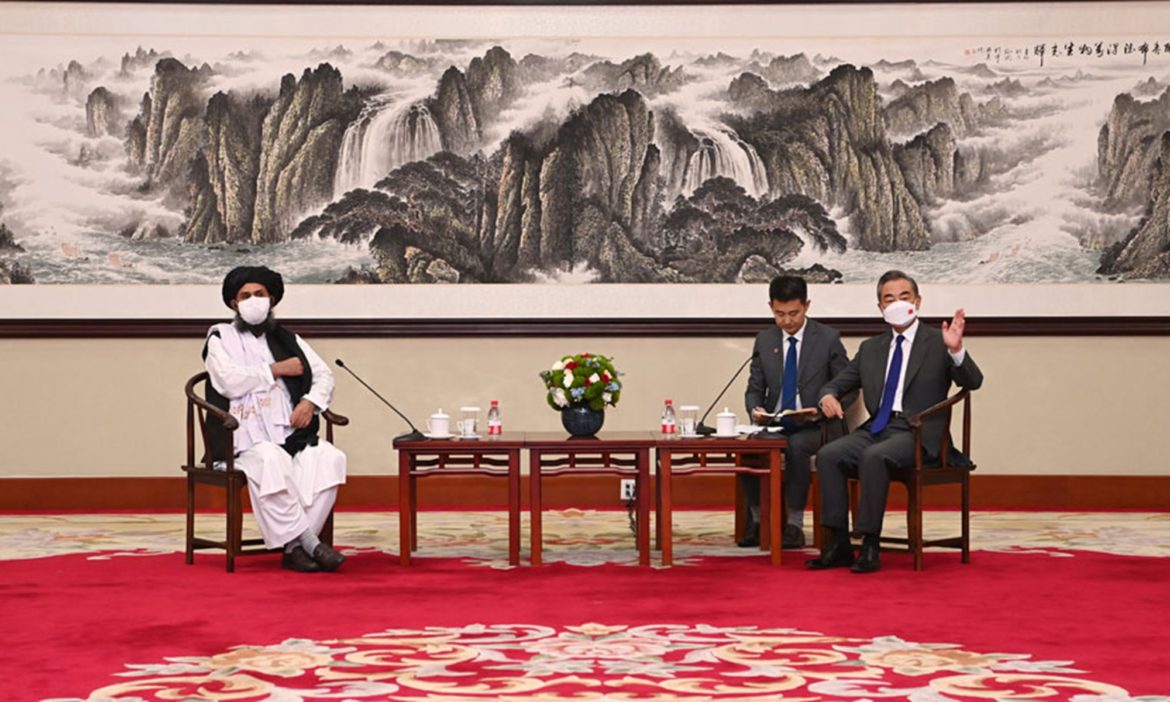Are women people? Why the Supreme Court just signed off on a Texas law that denies women's humanity
Amanda Marcotte, Salon
September 02, 2021

A distraught woman in the waiting room of a doctor's office (Shutterstock.com)
In 1915, the suffragist Alice Duer Miller wrote a delightful book of satirical poetry titled "Are Women People? A Book of Rhymes for Suffrage Times." Here we are, 106 years later, and Texas and the Supreme Court have weighed in with their opinion, which is very much no, women are not people. They are human-shaped, but they cannot be regarded as full people, capable of making very basic decisions about their own bodies and lives. After a full day of the Supreme Court not yet deciding whether to enjoin a Texas law banning all abortions two weeks after the first missed period, the court finally made a decision late Wednesday night. In full violation of Roe v. Wade, the Supreme Court is allowing Texas to ban abortion.
This is not, as the mansplainers will let you know, an official overturn of Roe. That is still coming, in the form of Dobbs v. Jackson Women's Health Organization, a case looking at another abortion ban in Mississippi that has been explicitly held out as an opportunity for the court to simply overturn the 1973 case that legalized abortion. Still, as Jessica Mason Pieklo, a legal expert at Rewire News Group writes, "Let's just get this out of the way: We can stop debating about whether the Court overturned Roe v. Wade. They did. So what if it's on a technicality? It's not a technicality to the people forced to carry pregnancies to term against their will."
The human cost of this last minute abortion ban can be felt in this piece at The 19th that details the scene at a clinic in Fort Worth at 8PM on Tuesday, when providers realized they only had four hours to help "two dozen people [who] were still waiting for the procedure," before the ban went into effect at midnight. It was a nightmare race against the clock, as the "staff worked without stopping to eat, shifting patients in and out of rooms." One woman "dropped to her knees on the cold tile floor," begging to get a place in line before the ban came down. All while a crowd of Christian fundamentalists, drunk on misogyny and their own victory, screamed at top volume outside.
As a writer, I've been covering the religious right over 15 years now. As a person who grew up in Texas, I've known these kinds of broken souls who support this law my whole life. They are small people, who spend their time trying to dominate the lives of others, rather than face up to the fears that prevent them from embracing full lives of their own. Donald Trump spoke to them, despite his barely concealed contempt for their religion, because they saw themselves in him: A man so poisoned by hate that his only real pleasure in life is bullying others. So, I get it, intellectually. On a deeper, emotional level, though, understanding will always elude me. How can so many give up their one precious life to cruelty, rather than just take the easier and humane path of "live and let live?"
At this point, these sadists will try to defend themselves by claiming this is all about "life." It's a lie that worked for decades to give cover to their malice. It's collapsed in the age of a deadly pandemic that conservatives are doing everything in their power to spread, a pandemic that is especially dangerous for the fetal life they only care for when it can be weaponized against women's rights.
No, the Texas law — and the Supreme Court endorsement of it — is about one thing and one thing only: Denying the humanity of women, and, of course, denying the humanity of those who don't neatly fit in that category of "woman," but can get pregnant anyway. This is about reducing these people to mere vessels, and rejecting the idea that they are autonomous human beings who have sovereignty over their bodies and their lives. On the contrary, having a uterus renders you as little more than human livestock in the eyes of conservatives.
We see this attitude in the enforcement mechanism of the law.
The law allows any person – even a complete stranger to the person getting an abortion — to sue an abortion provider or any other person who helps with the abortion. The right to control a pregnant person's body, in this Texas law, belongs quite literally to anyone but the woman herself: Her father, her husband, her ex, her neighbor, some random misogynist who just wants to ruin a life because he spends too much time on incel forums. Just so long as it's not the person actually living in that body.
This rejection of women as autonomous beings is also baked into the parameters of who can be sued. The abortion bounty hunters are permitted to go after health care providers or any other person who helps a woman get an abortion, but they cannot sue the person who wants an abortion. She is viewed simply as an empty vessel, not as a thinking, feeling person who is making a decision. And so the responsibility for the abortion decision is assumed to belong to another person, because conservatives simply cannot admit that women are capable of making such decisions.
This rejection of female autonomy is generally presented as chivalrous in anti-choice rhetoric, as if they are trying to "protect" women from abortion. The Texas Right to Life site defends the law as supposedly saving women "whose lives are irrevocably altered by the death of their children." They even use condescending memes like this, which erase the fact that it's women themselves choosing abortion.
Needless to say, there's piles of research showing that women's main feelings after abortion are relief, not grief. But even without that research, it's clear how offensive it is to pretend that women don't actively choose abortion. It's treating women like dumb animals, refusing to believe they have any more capacity to make reproductive decisions than a feral cat. It's ugly, dehumanizing rhetoric, no matter how much anti-choicers try to pass it off as "compassion."
That some of the people who are behind these kinds of laws are women themselves doesn't change this fact. Justice Amy Coney Barrett voted to uphold the Texas law, but she is also quite famously a religious fundamentalist, a status that reassures the religious right that she's simply upholding beliefs handed down to her by a patriarchal faith. As for the motivations of the female misogynists themselves, well, that's why Aunt Lydia of "The Handmaid's Tale" was such a good character. For women committed to living with, instead of resisting, male dominance, being an enforcer gives them power over other women. It's not quite as good as being a man, but hey, at least it gives you someone else to control and look down on.
Sadly, the misogyny baked into the Texas law is about to spread like wildfire across red America. The Supreme Court will not issue a formal ruling on whether Roe stands until next summer, but this support for the Texas law is an open invitation to every state legislature run by woman-hating Bible thumpers to pass versions of their own. Accompanying the law will be more dehumanizing rhetoric, treating women as livestock who can't be trusted to make decisions, or even acknowledged as capable of making decisions. Because debasing women has always been what the anti-choice movement is about. Now Americans will start to see the real life damage such hatred can wreak in women's lives.
Analysis: Texas legislators, with an assist from the U.S. Supreme Court, open a Pandora’s BoxAmanda Marcotte, Salon
September 02, 2021

A distraught woman in the waiting room of a doctor's office (Shutterstock.com)
In 1915, the suffragist Alice Duer Miller wrote a delightful book of satirical poetry titled "Are Women People? A Book of Rhymes for Suffrage Times." Here we are, 106 years later, and Texas and the Supreme Court have weighed in with their opinion, which is very much no, women are not people. They are human-shaped, but they cannot be regarded as full people, capable of making very basic decisions about their own bodies and lives. After a full day of the Supreme Court not yet deciding whether to enjoin a Texas law banning all abortions two weeks after the first missed period, the court finally made a decision late Wednesday night. In full violation of Roe v. Wade, the Supreme Court is allowing Texas to ban abortion.
This is not, as the mansplainers will let you know, an official overturn of Roe. That is still coming, in the form of Dobbs v. Jackson Women's Health Organization, a case looking at another abortion ban in Mississippi that has been explicitly held out as an opportunity for the court to simply overturn the 1973 case that legalized abortion. Still, as Jessica Mason Pieklo, a legal expert at Rewire News Group writes, "Let's just get this out of the way: We can stop debating about whether the Court overturned Roe v. Wade. They did. So what if it's on a technicality? It's not a technicality to the people forced to carry pregnancies to term against their will."
The human cost of this last minute abortion ban can be felt in this piece at The 19th that details the scene at a clinic in Fort Worth at 8PM on Tuesday, when providers realized they only had four hours to help "two dozen people [who] were still waiting for the procedure," before the ban went into effect at midnight. It was a nightmare race against the clock, as the "staff worked without stopping to eat, shifting patients in and out of rooms." One woman "dropped to her knees on the cold tile floor," begging to get a place in line before the ban came down. All while a crowd of Christian fundamentalists, drunk on misogyny and their own victory, screamed at top volume outside.
As a writer, I've been covering the religious right over 15 years now. As a person who grew up in Texas, I've known these kinds of broken souls who support this law my whole life. They are small people, who spend their time trying to dominate the lives of others, rather than face up to the fears that prevent them from embracing full lives of their own. Donald Trump spoke to them, despite his barely concealed contempt for their religion, because they saw themselves in him: A man so poisoned by hate that his only real pleasure in life is bullying others. So, I get it, intellectually. On a deeper, emotional level, though, understanding will always elude me. How can so many give up their one precious life to cruelty, rather than just take the easier and humane path of "live and let live?"
At this point, these sadists will try to defend themselves by claiming this is all about "life." It's a lie that worked for decades to give cover to their malice. It's collapsed in the age of a deadly pandemic that conservatives are doing everything in their power to spread, a pandemic that is especially dangerous for the fetal life they only care for when it can be weaponized against women's rights.
No, the Texas law — and the Supreme Court endorsement of it — is about one thing and one thing only: Denying the humanity of women, and, of course, denying the humanity of those who don't neatly fit in that category of "woman," but can get pregnant anyway. This is about reducing these people to mere vessels, and rejecting the idea that they are autonomous human beings who have sovereignty over their bodies and their lives. On the contrary, having a uterus renders you as little more than human livestock in the eyes of conservatives.
We see this attitude in the enforcement mechanism of the law.
The law allows any person – even a complete stranger to the person getting an abortion — to sue an abortion provider or any other person who helps with the abortion. The right to control a pregnant person's body, in this Texas law, belongs quite literally to anyone but the woman herself: Her father, her husband, her ex, her neighbor, some random misogynist who just wants to ruin a life because he spends too much time on incel forums. Just so long as it's not the person actually living in that body.
This rejection of women as autonomous beings is also baked into the parameters of who can be sued. The abortion bounty hunters are permitted to go after health care providers or any other person who helps a woman get an abortion, but they cannot sue the person who wants an abortion. She is viewed simply as an empty vessel, not as a thinking, feeling person who is making a decision. And so the responsibility for the abortion decision is assumed to belong to another person, because conservatives simply cannot admit that women are capable of making such decisions.
This rejection of female autonomy is generally presented as chivalrous in anti-choice rhetoric, as if they are trying to "protect" women from abortion. The Texas Right to Life site defends the law as supposedly saving women "whose lives are irrevocably altered by the death of their children." They even use condescending memes like this, which erase the fact that it's women themselves choosing abortion.
Needless to say, there's piles of research showing that women's main feelings after abortion are relief, not grief. But even without that research, it's clear how offensive it is to pretend that women don't actively choose abortion. It's treating women like dumb animals, refusing to believe they have any more capacity to make reproductive decisions than a feral cat. It's ugly, dehumanizing rhetoric, no matter how much anti-choicers try to pass it off as "compassion."
That some of the people who are behind these kinds of laws are women themselves doesn't change this fact. Justice Amy Coney Barrett voted to uphold the Texas law, but she is also quite famously a religious fundamentalist, a status that reassures the religious right that she's simply upholding beliefs handed down to her by a patriarchal faith. As for the motivations of the female misogynists themselves, well, that's why Aunt Lydia of "The Handmaid's Tale" was such a good character. For women committed to living with, instead of resisting, male dominance, being an enforcer gives them power over other women. It's not quite as good as being a man, but hey, at least it gives you someone else to control and look down on.
Sadly, the misogyny baked into the Texas law is about to spread like wildfire across red America. The Supreme Court will not issue a formal ruling on whether Roe stands until next summer, but this support for the Texas law is an open invitation to every state legislature run by woman-hating Bible thumpers to pass versions of their own. Accompanying the law will be more dehumanizing rhetoric, treating women as livestock who can't be trusted to make decisions, or even acknowledged as capable of making decisions. Because debasing women has always been what the anti-choice movement is about. Now Americans will start to see the real life damage such hatred can wreak in women's lives.
The country just noticed what Texas was doing, and although Texans have been watching the debate over this anti-abortion law all year, even some of them were surprised at how quickly the legally protected right to abortion disappeared.
BY ROSS RAMSEY
SEPT. 2, 2021
The Texas Tribune
/https://static.texastribune.org/media/files/9894214aba3ce0fde44cc3a7e0749aa0/SCOTUS%20Abortion%20Rally%20REUTERS.jpg)
/https://static.texastribune.org/media/files/9894214aba3ce0fde44cc3a7e0749aa0/SCOTUS%20Abortion%20Rally%20REUTERS.jpg)
Protesters outside of the U.S. Supreme Court in Washington, D.C., on May 21, 2019. Credit: Stefani Reynolds/CNP/ABACAPRESS.COM via REUTERS
The state of Texas has figured out, at least for now, how to do unconstitutional things in a way that doesn’t raise a majority of the eyebrows in the U.S. Supreme Court.
The court turned back a legal effort by abortion providers to stop the state’s new ban on abortions after six weeks of pregnancy while that new law is being litigated. It means most abortions are illegal in Texas and will remain so unless the courts eventually find the new law unconstitutional. Some justices already have said as much.
The peculiar enforcement built into the law seemed to baffle the judges, as it was intended to do. Instead of the state enforcing the law — the normal way these things work — the state’s anti-abortion measure leaves that to private citizens, who are empowered to sue anyone who “aids or abets” someone seeking an abortion — from the doctors who perform abortions to someone who drives a woman to a clinic. It includes a “bounty hunter” provision that allows someone who successfully files a suit to collect $10,000 on top of legal fees.
In its 5-4 ruling, the court didn’t rule on the law itself. The unsigned majority opinion wrestled with the enforcement scheme, saying “it is unclear whether the named defendants in this lawsuit can or will seek to enforce the Texas law against the applicants in a manner that might permit our intervention.”
Chief Justice John Roberts, in his dissent, called the law “not only unusual, but unprecedented.” He wrote the first of the four dissents: “The State defendants argue that they cannot be restrained from enforcing their rules because they do not enforce them in the first place. I would grant preliminary relief to preserve the status quo ante — before the law went into effect — so that the courts may consider whether a state can avoid responsibility for its laws in such a manner.”
Justice Steven Breyer said it this way: “Texas’s law delegates to private individuals the power to prevent a woman from obtaining an abortion during the first stage of pregnancy. But a woman has a federal constitutional right to obtain an abortion during that first stage.”
Citing a previous opinion, he added: “we have made clear that ‘since the State cannot regulate or proscribe abortion during the first stage… the State cannot delegate authority to any particular person… to prevent abortion during that same period.’ The applicants persuasively argue that Texas’s law does precisely that.”
Here’s a question: If you can impede someone’s constitutional rights with an odd citizen enforcement strategy, what’s the limit? Abortion is in that category because the Supreme Court has ruled that women have such a right. If it can be undermined, other rights, like voting and speech and all the others, are subject to the same risk.
Justice Sonia Sotomayor said it like this: “The Court’s order is stunning. Presented with an application to enjoin a flagrantly unconstitutional law engineered to prohibit women from exercising their constitutional rights and evade judicial scrutiny, a majority of Justices have opted to bury their heads in the sand… In effect, the Texas Legislature has deputized the State’s citizens as bounty hunters, offering them cash prizes for civilly prosecuting their neighbors’ medical procedures.”
Put the state’s new voting law through that logic, and the worst scenes from the 2020 elections start to look like a good day at Six Flags Over Texas.
Here’s Justice Elena Kagan: “Without full briefing or argument, and after less than 72 hours’ thought, this Court greenlights the operation of Texas’s patently unconstitutional law banning most abortions. The Court thus rewards Texas’s scheme to insulate its law from judicial review by deputizing private parties to carry out unconstitutional restrictions on the State’s behalf.”
The country just noticed Texas, and although Texans have been watching the debate over this law all year, even some of them are surprised at how quickly the legally protected right to abortion disappeared.
Republican voters in Texas (74%) strongly support making abortion illegal after six weeks of pregnancy — a restriction that eliminates an estimated 85% of all abortions in the state. Among Democrats, 67% oppose that idea, but they’re not in power in state government. Those differences are no surprise to anyone who follows Texas politics.
That enforcement idea, though — bounty-financed citizen brigades in place of law enforcement — is a new twist. The courts will figure it out in time, and if the law remains in place, so will all those fine folks you see on social media. The same kind of crowd-sourcing that makes social media so toxic could do the same for some kinds of law enforcement. Creative lawmakers will use it again, the better to get around investigators and prosecutors they don’t like.
The mob can decide instead.
The state of Texas has figured out, at least for now, how to do unconstitutional things in a way that doesn’t raise a majority of the eyebrows in the U.S. Supreme Court.
The court turned back a legal effort by abortion providers to stop the state’s new ban on abortions after six weeks of pregnancy while that new law is being litigated. It means most abortions are illegal in Texas and will remain so unless the courts eventually find the new law unconstitutional. Some justices already have said as much.
The peculiar enforcement built into the law seemed to baffle the judges, as it was intended to do. Instead of the state enforcing the law — the normal way these things work — the state’s anti-abortion measure leaves that to private citizens, who are empowered to sue anyone who “aids or abets” someone seeking an abortion — from the doctors who perform abortions to someone who drives a woman to a clinic. It includes a “bounty hunter” provision that allows someone who successfully files a suit to collect $10,000 on top of legal fees.
In its 5-4 ruling, the court didn’t rule on the law itself. The unsigned majority opinion wrestled with the enforcement scheme, saying “it is unclear whether the named defendants in this lawsuit can or will seek to enforce the Texas law against the applicants in a manner that might permit our intervention.”
Chief Justice John Roberts, in his dissent, called the law “not only unusual, but unprecedented.” He wrote the first of the four dissents: “The State defendants argue that they cannot be restrained from enforcing their rules because they do not enforce them in the first place. I would grant preliminary relief to preserve the status quo ante — before the law went into effect — so that the courts may consider whether a state can avoid responsibility for its laws in such a manner.”
Justice Steven Breyer said it this way: “Texas’s law delegates to private individuals the power to prevent a woman from obtaining an abortion during the first stage of pregnancy. But a woman has a federal constitutional right to obtain an abortion during that first stage.”
Citing a previous opinion, he added: “we have made clear that ‘since the State cannot regulate or proscribe abortion during the first stage… the State cannot delegate authority to any particular person… to prevent abortion during that same period.’ The applicants persuasively argue that Texas’s law does precisely that.”
Here’s a question: If you can impede someone’s constitutional rights with an odd citizen enforcement strategy, what’s the limit? Abortion is in that category because the Supreme Court has ruled that women have such a right. If it can be undermined, other rights, like voting and speech and all the others, are subject to the same risk.
Justice Sonia Sotomayor said it like this: “The Court’s order is stunning. Presented with an application to enjoin a flagrantly unconstitutional law engineered to prohibit women from exercising their constitutional rights and evade judicial scrutiny, a majority of Justices have opted to bury their heads in the sand… In effect, the Texas Legislature has deputized the State’s citizens as bounty hunters, offering them cash prizes for civilly prosecuting their neighbors’ medical procedures.”
Put the state’s new voting law through that logic, and the worst scenes from the 2020 elections start to look like a good day at Six Flags Over Texas.
Here’s Justice Elena Kagan: “Without full briefing or argument, and after less than 72 hours’ thought, this Court greenlights the operation of Texas’s patently unconstitutional law banning most abortions. The Court thus rewards Texas’s scheme to insulate its law from judicial review by deputizing private parties to carry out unconstitutional restrictions on the State’s behalf.”
The country just noticed Texas, and although Texans have been watching the debate over this law all year, even some of them are surprised at how quickly the legally protected right to abortion disappeared.
Republican voters in Texas (74%) strongly support making abortion illegal after six weeks of pregnancy — a restriction that eliminates an estimated 85% of all abortions in the state. Among Democrats, 67% oppose that idea, but they’re not in power in state government. Those differences are no surprise to anyone who follows Texas politics.
That enforcement idea, though — bounty-financed citizen brigades in place of law enforcement — is a new twist. The courts will figure it out in time, and if the law remains in place, so will all those fine folks you see on social media. The same kind of crowd-sourcing that makes social media so toxic could do the same for some kinds of law enforcement. Creative lawmakers will use it again, the better to get around investigators and prosecutors they don’t like.
The mob can decide instead.
“It’s Just Unbelievably Cruel”: Texas’s New Abortion Law Is Already Impacting People
“It creates all these hurdles that people have to jump over just to access basic, essential time-sensitive healthcare," one advocate said.
BuzzFeed News Reporter
Posted on September 1, 2021,

Sergio Flores / Getty Images
A protester outside the Texas state Capitol in Austin after Gov. Greg Abbott signed the bill into law on May 29, 2021.
Hours after Texas’s latest and most draconian abortion law went into effect, the few clinics left in the state opened their doors on Wednesday under a drastically different reality in which patients face a whole new set of challenges.
“It's hard enough yesterday for a person living in rural Texas to make it to one of the very few clinics we have serving our state,” Cristina Parker with the Lilith Fund told BuzzFeed News. “It creates all these hurdles that people have to jump over just to access basic, essential time-sensitive healthcare. It's just unbelievably cruel.”
The law, SB 8, went into effect at the stroke of midnight after the Supreme Court failed to take action on an emergency appeal, effectively outlawing the vast majority of abortion procedures overnight. It bans abortions as soon as cardiac activity is detected in the fetus, which could be as early as 6 weeks, or a single missed period. It also enables members of the public to enforce the law, allowing them to sue anyone involved in the abortion — from abortion providers to the person who drives a patient to the clinic or lends them money for the procedure.
“This law doesn't do anything to prevent unplanned pregnancies, to support people, to build families, and to [give] them resources. It doesn't do anything to comfort people or provide healthcare,” Amy Hagstrom Miller of Whole Woman’s Health, the lead plaintiff in the lawsuit to block SB 8, told BuzzFeed News. “It's blocking people who need safe and legal abortion care from getting that care with trained professionals like us.”
Already a state with some of the most restrictive abortion laws in the country, Texas requires patients to undergo a sonogram, where an abortion provider must display and explain the image; receive a state-mandated booklet about the fetus’s development and adoption alternatives that contains false information; and then wait 24 hours before the procedure can be performed. Dozens of abortion clinics in Texas have closed down in the past decade, forcing patients to travel hours to reach a provider. State law also forbids health insurance companies from covering abortion except in extreme situations where the pregnant person’s life is at risk.
Advocates who spoke to BuzzFeed News said the latest restriction will send more people out of state for abortions, but realistically, that option is simply out of reach for many people who do not have the resources to travel and who will be forced to carry unwanted pregnancies to term.
The law also further complicates things for minors who want to get an abortion without parental consent, said Rosann Mariappuram, the executive director of Jane’s Due Process, a group that helps Texas teenagers under 18 access abortion, including obtaining a court order that allows a minor to bypass parental consent or notification for an abortion.
“It’s incredibly hard because they are minors. They just don't have the resources, or in some cases, the privacy to leave the state, because leaving would then basically reveal they're pregnant,” Mariappuram told BuzzFeed News. “So for our clients, we're concerned that this law is a total abortion ban.”
The Supreme Court’s silence on the case has left Texas abortion rights in limbo. Abortion providers are complying with the new law while waiting for a possible injunction that would provide immediate, though temporary, relief for patients further along than 6 weeks in their pregnancy. But that also forces patients to decide between two difficult options: Do they try to travel out of state for an abortion as soon as they can, or do they wait and hope the Supreme Court blocks the law before they reach the state’s previous limit at 20 weeks gestation?
“Someone who maybe is more able to travel is probably looking at travel as a more viable option, but someone who's not is probably just sitting and hoping that the Supreme Court does the right thing for Texans,” Parker said.
Advocacy groups say they are frustrated that the law essentially happened overnight because of the Supreme Court’s inaction.
“This is basically taking away the right to abortion in Texas — is that not an emergency? Why has the court not intervened?” Mariappuram said.
Many fear that the law will have a chilling effect on Texans who want an abortion. A “haunting quietness” set on the Lilith Fund hotline on Wednesday morning, Parker said, though she hopes it will pick up as people start scheduling appointments out of state.
In the days leading up to the midnight deadline, Fund Texas Choice, a fund that helps Texans pay for travel expenses to go to an abortion clinic, fielded calls from multiple people asking about SB 8, said co-executive director Anna Rupani.
Rupani told BuzzFeed News that Fund Texas Choice has had to stress to patients that abortion, though severely limited, is not totally outlawed in the state.
“People think that it's completely illegal and they're not going to get any access to services, period, from here on out,” she said. “So just reminding folks that, even though it's harder to access, Texas organizations on the ground are willing and able to support you. And if you reach out, we will be there.”
Posted on September 1, 2021,

Sergio Flores / Getty Images
A protester outside the Texas state Capitol in Austin after Gov. Greg Abbott signed the bill into law on May 29, 2021.
Hours after Texas’s latest and most draconian abortion law went into effect, the few clinics left in the state opened their doors on Wednesday under a drastically different reality in which patients face a whole new set of challenges.
“It's hard enough yesterday for a person living in rural Texas to make it to one of the very few clinics we have serving our state,” Cristina Parker with the Lilith Fund told BuzzFeed News. “It creates all these hurdles that people have to jump over just to access basic, essential time-sensitive healthcare. It's just unbelievably cruel.”
The law, SB 8, went into effect at the stroke of midnight after the Supreme Court failed to take action on an emergency appeal, effectively outlawing the vast majority of abortion procedures overnight. It bans abortions as soon as cardiac activity is detected in the fetus, which could be as early as 6 weeks, or a single missed period. It also enables members of the public to enforce the law, allowing them to sue anyone involved in the abortion — from abortion providers to the person who drives a patient to the clinic or lends them money for the procedure.
“This law doesn't do anything to prevent unplanned pregnancies, to support people, to build families, and to [give] them resources. It doesn't do anything to comfort people or provide healthcare,” Amy Hagstrom Miller of Whole Woman’s Health, the lead plaintiff in the lawsuit to block SB 8, told BuzzFeed News. “It's blocking people who need safe and legal abortion care from getting that care with trained professionals like us.”
Already a state with some of the most restrictive abortion laws in the country, Texas requires patients to undergo a sonogram, where an abortion provider must display and explain the image; receive a state-mandated booklet about the fetus’s development and adoption alternatives that contains false information; and then wait 24 hours before the procedure can be performed. Dozens of abortion clinics in Texas have closed down in the past decade, forcing patients to travel hours to reach a provider. State law also forbids health insurance companies from covering abortion except in extreme situations where the pregnant person’s life is at risk.
Advocates who spoke to BuzzFeed News said the latest restriction will send more people out of state for abortions, but realistically, that option is simply out of reach for many people who do not have the resources to travel and who will be forced to carry unwanted pregnancies to term.
The law also further complicates things for minors who want to get an abortion without parental consent, said Rosann Mariappuram, the executive director of Jane’s Due Process, a group that helps Texas teenagers under 18 access abortion, including obtaining a court order that allows a minor to bypass parental consent or notification for an abortion.
“It’s incredibly hard because they are minors. They just don't have the resources, or in some cases, the privacy to leave the state, because leaving would then basically reveal they're pregnant,” Mariappuram told BuzzFeed News. “So for our clients, we're concerned that this law is a total abortion ban.”
The Supreme Court’s silence on the case has left Texas abortion rights in limbo. Abortion providers are complying with the new law while waiting for a possible injunction that would provide immediate, though temporary, relief for patients further along than 6 weeks in their pregnancy. But that also forces patients to decide between two difficult options: Do they try to travel out of state for an abortion as soon as they can, or do they wait and hope the Supreme Court blocks the law before they reach the state’s previous limit at 20 weeks gestation?
“Someone who maybe is more able to travel is probably looking at travel as a more viable option, but someone who's not is probably just sitting and hoping that the Supreme Court does the right thing for Texans,” Parker said.
Advocacy groups say they are frustrated that the law essentially happened overnight because of the Supreme Court’s inaction.
“This is basically taking away the right to abortion in Texas — is that not an emergency? Why has the court not intervened?” Mariappuram said.
Many fear that the law will have a chilling effect on Texans who want an abortion. A “haunting quietness” set on the Lilith Fund hotline on Wednesday morning, Parker said, though she hopes it will pick up as people start scheduling appointments out of state.
In the days leading up to the midnight deadline, Fund Texas Choice, a fund that helps Texans pay for travel expenses to go to an abortion clinic, fielded calls from multiple people asking about SB 8, said co-executive director Anna Rupani.
Rupani told BuzzFeed News that Fund Texas Choice has had to stress to patients that abortion, though severely limited, is not totally outlawed in the state.
“People think that it's completely illegal and they're not going to get any access to services, period, from here on out,” she said. “So just reminding folks that, even though it's harder to access, Texas organizations on the ground are willing and able to support you. And if you reach out, we will be there.”
Here's How The Supreme Court Can Rule In A Major Abortion Case In The Dead Of Night
It usually takes the Supreme Court months to rule in a case. But there’s a back door, and it’s getting a lot of use.

Pool / Getty Images
That could describe last night’s order explaining the court’s 5–4 decision to let Texas’s 6-week abortion ban take effect while a constitutional challenge works through the lower courts. Or it could describe the order from April pulling back restrictions that California had imposed on small gatherings during the coronavirus pandemic. Or the one issued just before Thanksgiving last year halting certain COVID-19 rules in New York
The Supreme Court’s handling of the Texas abortion law spurred the latest round of scrutiny — and criticism — over how the justices make consequential decisions via the “shadow docket.” The term refers to emergency petitions that ask for a swift ruling on time-sensitive issues, often while a case is still being litigated in the lower courts, without going through the usual monthslong process that involves rounds of briefing, public argument, and, ultimately, an opinion that explains the court’s reasoning and sets precedent for the rest of the country.
Justice Elena Kagan, one of the four justices who disagreed with the majority’s decision to let Texas’s SB 8 go into effect on Wednesday, wrote a short dissent blasting her colleagues for tipping the scales in favor of Texas and dramatically upending the state of abortion law in this way.
“In all these ways, the majority’s decision is emblematic of too much of this Court’s shadow docket decisionmaking — which every day becomes more unreasoned, inconsistent, and impossible to defend,” she wrote.
The fight over SB 8 reached the justices on Aug. 30. A federal appeals court had paused proceedings before a federal judge in Austin — including a request by abortion providers to temporarily pause SB 8 while the case was pending — and the abortion providers filed an emergency application asking the justices to intervene. They asked the Supreme Court to either halt SB 8 directly to allow time for the lower courts to sort the case out or to at least allow the judge in Austin to rule before the Sept. 1 start date.
When the clock struck 12 a.m. Central time on Sept. 1, and there was no word from the justices, SB 8 became law in the state. It bans physicians from performing abortions after around the sixth week of a pregnancy and deputizes private individuals to enforce the law by filing a civil lawsuit against any provider they suspect of performing a now-illegal abortion or anyone else who knowingly helped facilitate an abortion covered by the law, including by paying for it. The law allows plaintiffs who win to collect at least $10,000 in damages per abortion, plus their legal costs; if a case is dismissed, however, the law bars judges from ordering the person who filed an unsuccessful claim to similarly pay up.
At 11:58 p.m. on Sept. 1, nearly 24 hours after the justices’ silence meant the law would take effect, the Supreme Court released an order. It confirmed that a majority of justices intended for SB 8 to go forward; four justices — Chief Justice John Roberts Jr. and Justices Stephen Breyer, Sonia Sotomayor, and Kagan — dissented.
The court has weighed in on a host of major political fights in recent years via the shadow docket — not always literally at midnight, but sometimes close. An Aug. 26 order halting the Biden administration’s effort at keeping a federal eviction moratorium active during the coronavirus pandemic came in a little before 9:30 p.m. Two days earlier, the court issued a one-paragraph order that mandated the administration resume a Trump-era immigration policy that forced people seeking asylum to wait in Mexico while their case was pending.
A survey of shadow docket activity during former president Donald Trump’s time in office by Steve Vladeck, a professor at the University of Texas School of Law, found that the Justice Department went to the Supreme Court more than three dozen times to halt lower court rulings against the administration; a majority of the justices sided with the government in more than half of those cases
The shadow docket didn’t start under Trump, although it did get more attention given how frequently legal fights over administration policies and practices landed before the justices on that track. These types of emergency actions have been common for years in death penalty cases. People on death row who have lost every other option for halting their execution have petitioned the justices to step in at the last minute; these efforts are usually unsuccessful.
University of Chicago Law School professor William Baude is credited with coming up with the term “shadow docket.” In a 2015 op-ed in the New York Times, he noted that the court had a history of handling politically and socially fraught issues via the shadow docket. For instance, Baude, who had clerked for Roberts, pointed out that there were orders related to whether same-sex couples could get married while constitutional challenges worked their way through the lower courts, ultimately culminating in 2015’s landmark decision that recognized a nationwide right to marriage.
In the months leading up to the 2020 presidential election, the justices weighed in on a string of cases via the shadow docket that dealt with how people could cast their ballot during a deadly global pandemic. There were orders that restricted voting options, including allowing Alabama to ban local officials from offering curbside voting for people with disabilities and reinstating a South Carolina law requiring absentee voters to have someone witness the signing of their ballot. There were orders that permitted some states to extend deadlines for absentee voters — including in Pennsylvania and North Carolina — and an order blocking an extended timeline in Wisconsin
The court generally considers four factors when deciding whether to intervene in a case on an emergency basis: whether there’s a good chance at least four justices would vote to hear the case later when it formally reached the court; whether there’s a “fair prospect” that the justices would reverse whatever decision is before them on an emergency basis; whether a party would face “irreparable harm” absent immediate action from the court; and, finally, who would be hurt most in the meantime.In the Texas case, the dissenting justices wrote that their colleagues had turned the purpose of the shadow docket on its head. Roberts pointed out that there hadn’t been any ruling from a federal appeals court yet on the procedural questions that the majority cited in letting SB 8 take effect, and he wrote that the court shouldn’t upend the status quo — all but halting abortion access in Texas — until those issues could at least get a little more airing below.
The other three dissenters wrote separately to make clear they believed SB 8 was unconstitutional; Roberts didn’t go that far. Kagan focused on the shadow docket issue, writing that it was a problem for the court to effectively decide a major case like this one in just a few days.
“Without full briefing or argument, and after less than 72 hours’ thought, this Court greenlights the operation of Texas’s patently unconstitutional law banning most abortions,” Kagan wrote.
Sotomayor and Breyer also called out the majority for letting the law take effect under these circumstances and underscored how much it would harm pregnant people in Texas in the meantime. Sotomayor cited a statistic presented by abortion providers that around 85% of abortions performed in the state took place after the 6-week mark.
“The Court’s order is stunning,” Sotomayor wrote. “Presented with an application to enjoin a flagrantly unconstitutional law engineered to prohibit women from exercising their constitutional rights and evade judicial scrutiny, a majority of Justices have opted to bury their heads in the sand.”















